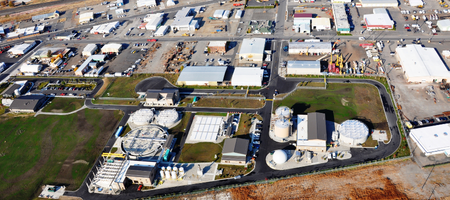Water Resource Recovery Facility Spotlight — Spokane County Regional Water Reclamation Facility

In the 1970s, Spokane County noticed that septic tanks in the area posed a threat to the Spokane Valley Rathdrum Prairie Aquifer, especially as urban growth increased in the Spokane Valley. This aquifer is the primary source of drinking water for Spokane County, Washington and Kootenai County, Idaho. So, in the 1980s, the County led an effort to install sewers throughout urbanized areas of Spokane County, eliminate septic systems, and connect homes and businesses to a centralized sewer system. During that effort, all regional wastewater was treated at the City of Spokane’s Riverside Park Water Reclamation Facility.
In 2011, Spokane County diverted a portion of that wastewater to be treated at the newly constructed Spokane County Regional Water Reclamation Facility (SCRWRF), which was procured by Spokane County through a design-build-operate contract with CH2M Hill (now Jacobs), with the operations contract running until 2031. The SCRWRF uses a membrane bioreactor system to treat 8 million gallons of sewage each day. The treated water is equivalent to Class A reclaimed water and is used for process water and on-site irrigation, the majority of which is discharged to the Spokane River. Further uses for the reclaimed water in the area, such as wetland restoration or aquifer recharge, have been explored and remain potential options for the future.
The current SCRWRF treatment process consists of 3 mm mechanical band screening, aerated grit removal, primary clarification, primary effluent equalization, step-feed aeration, membrane filtration, sodium hypochlorite disinfection, and dechlorination. Primary and waste-activated sludge are separated from the liquids treatment process, blended, and thickened on gravity belt thickeners. Thickened sludge is pumped into two anaerobic digesters with a solids retention time of 15 days to create Class B biosolids. Digested sludge is moved to the aerobic digester, then dewatered with centrifuges. Then, dewatered biosolids are composted by a contract facility for soil amendment.
The microorganisms in the anaerobic digesters reduce the organic matter of the sludge with a volatile solids reduction of 50-60% and create biogas as a byproduct. This biogas is cleaned with a foam separator and sediment trap to prevent damage to equipment further along in the process.
The primary end-use for the biogas is to fire co-generation microturbines producing electricity to power the facility and heat to return to the anaerobic digesters. Gas used in the microturbines requires additional drying and scrubbing to remove water vapor and other impurities. The four 65 kW microturbines each produce an average of 775 kWh/day for a total production of 3,100 kWh/day. The SCRWRF uses about 28,000 kWh/day, so the microturbines typically produce about 11% of the electricity needed to run the facility. Biogas can also be burned in a boiler to provide heat to the anaerobic digesters. Any biogas that cannot be used in the microturbines or in the boiler is flared. The County plans to continue exploring resource recovery options in the future, such as producing renewable natural gas or recovering energy through a turbine on the outfall line.
